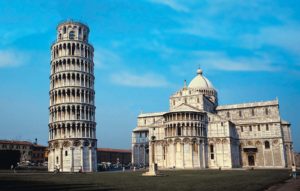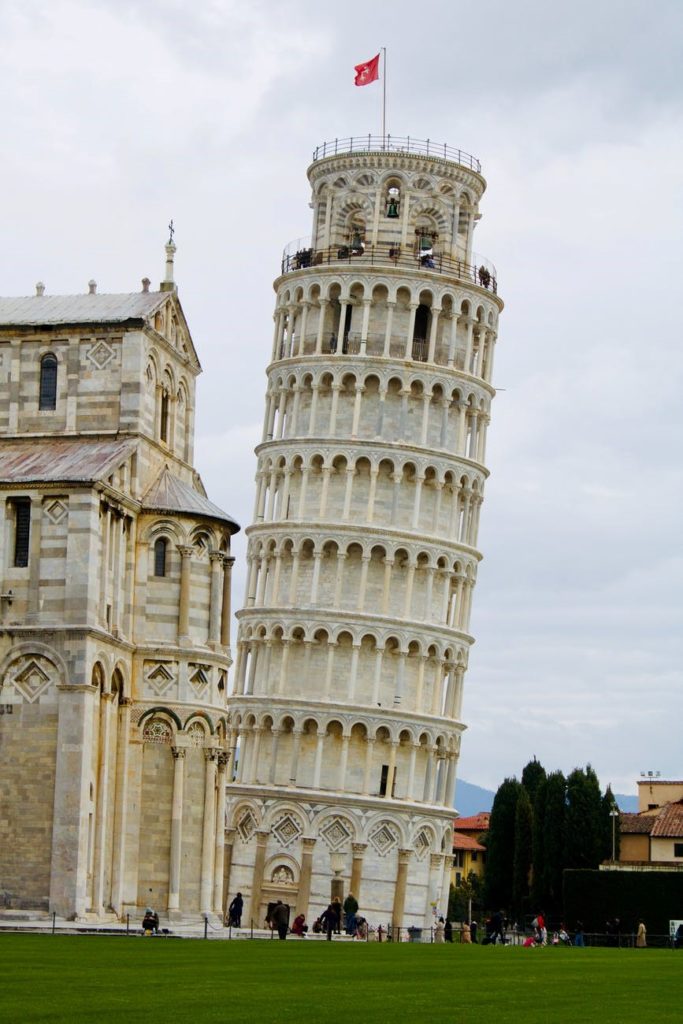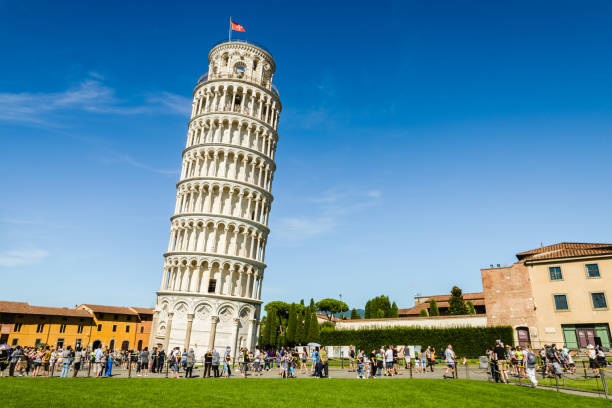
The Leaning Tower of Pisa is one of the most well-known towers in the world and one of the most remarkable pieces of Romanesque architecture in all of Italy. In the Italian language, this tower is called Torre Pendente di Pisa. Travelers come from all over the globe to marvel at this famous gravity-defying structure. Galileo Galilei made a remarkable study that took place from the top of the leaning tower. Legend has it that he climbed to the top of the tower and simultaneously dropped one heavy and one light ball. Surprisingly he saw that they both hit the ground at the same time. He, therefore proved, contrary to ancient claims, that heavy and light objects (“bodies”) fell at the same rate.
Here is another interesting fact about the Leaning Tower of Pisa. The architects’ original intent wasn’t to make the tower lean, its obvious tilt is why it’s called one of the Seven Wonders of the Medieval World and was declared a UNESCO World Heritage Site in 1987. So, why is Pisa an important city? Why is the famous tower tilted? Why was it built in the first place? Find out the answers to all these questions and more as you continue to read this blog post.
Pisa: A Great City
The city of Pisa began as a simple seaport, all of this changed drastically as the city headed towards the 12th century. As the city grew, it became involved in different trade agreements and military conflicts, becoming increasingly powerful and wealthy. This new wealth was invested back into the city, with Pisa constructing grand buildings to show its prosperity. Eventually, the city became one of Italy’s grandest maritime republics.
In 1603, Pisa attacked Palermo, Sicily, and won. They brought home the spoils of war and decided to use the opportunity to show the world how important their city was and the mighty strength of Pisa. The plan was to construct on a large parcel of land the “Field of Miracles,” a cathedral complex that would include the Leaning Tower, a baptistery, a cemetery, and a duomo.
Why Was the Leaning Tower of Pisa Built?
As mentioned earlier the tower wasn’t supposed to lean at all. It was designed to be a traditional bell tower. In fact, the only thing to set it apart was the height of the tower since it was meant to be the tallest bell tower ever constructed in its day. Unfortunately, what would happen next threw a curveball in the construction process and what followed was centuries of trying to fix a costly architectural accident.
The Pisa Tower and Its Infamous Tilt

The construction of the bell tower began in 1173. However, wars, engineering issues, and more interruptions delayed the construction by two centuries. In hindsight, these interruptions and standstills in construction led to soil compression under the foundation. Believe it or not had these interruptions, not taken place, the famous tower wouldn’t just learn – it would have fallen over.
Why Does the Pisa Tower Lean?
Unbeknownst to the architects, the Leaning Tower of Pisa was doomed from the start. The Square of Miracles was built in between the Serchio and Arno rivers in Tuscany and the ground the tower was built on was soft and consisting of clay and sand. The foundation for the Leaning Tower of Pisa was both shallow and heavy and began to settle unevenly into the spongy ground. After the third story was completed, there was a visible tilt to the structure. The project was halted since one of the designers, Bonanno Pisano didn’t want to ruin his reputation, and then Pisa had begun a war with its arch-rival Genoa.
Have Engineers Tried to Fix It?
In 1295, a renowned architect named Giovanni di Simone tried to lend his expertise. He built the next four stories at a straight angle and used smaller components to remedy the leaning. Unfortunately, this extra weight only served to make matters worse. The tower now began to lean in a different direction since the center of gravity was thrown off. Construction continued, and the original tilt returned, which is still seen to this day.
In the 20th century, Italian dictator Mussolini was ashamed of the tilt and deemed it an embarrassment. His efforts to drill holes in the base to add grout and mortar simply made the base heavier and caused it to lean more. After various attempts to fix the tilt over the years, engineers finally got it right in the 21st century. Not only did they siphon earth from under the tower, but they also added counterweights to balance the tower. As a result, the lean was reduced from over 15 ft to 13.5 ft. The tower, which had been falling for over 800 years, was finally found to have stopped doing so in 2008.
The Leaning Tower of Pisa Today
When the Italian government stabilized the famous tower, they didn’t completely fix it. They appreciated the idea of the tilt since that’s what made it so unique, to begin with. Engineers now think that the Leaning Tower of Pisa is stable, and given that no extreme circumstances (such as earthquakes) occur, it will remain so for about 200 more years.
Today, tourists are able to climb to the top of this historic tower. While it’s a strange experience since they have to walk in a narrow structure with a tilt. Still millions of people around the world flock to see this incredible tower in all its glory. While the Leaning Tower of Pisa isn’t what its designers originally dreamed up, it’s nonetheless an architectural marvel. The sheer length of the project, combined with multiple failures to stop the tilt and years of work to make it what it is today, sets the Pisa Tower apart from all other bell towers throughout Italy.
Additionally, while the tilt is one of the primary reasons it’s so well-known, anyone who goes to see the Leaning Tower of Pisa will certainly be awed by its beautiful Gothic and Romanesque construction along with the cathedral and baptistery surrounding it. The climb may be a little strange, but the stunning views from the top are completely worth it.


